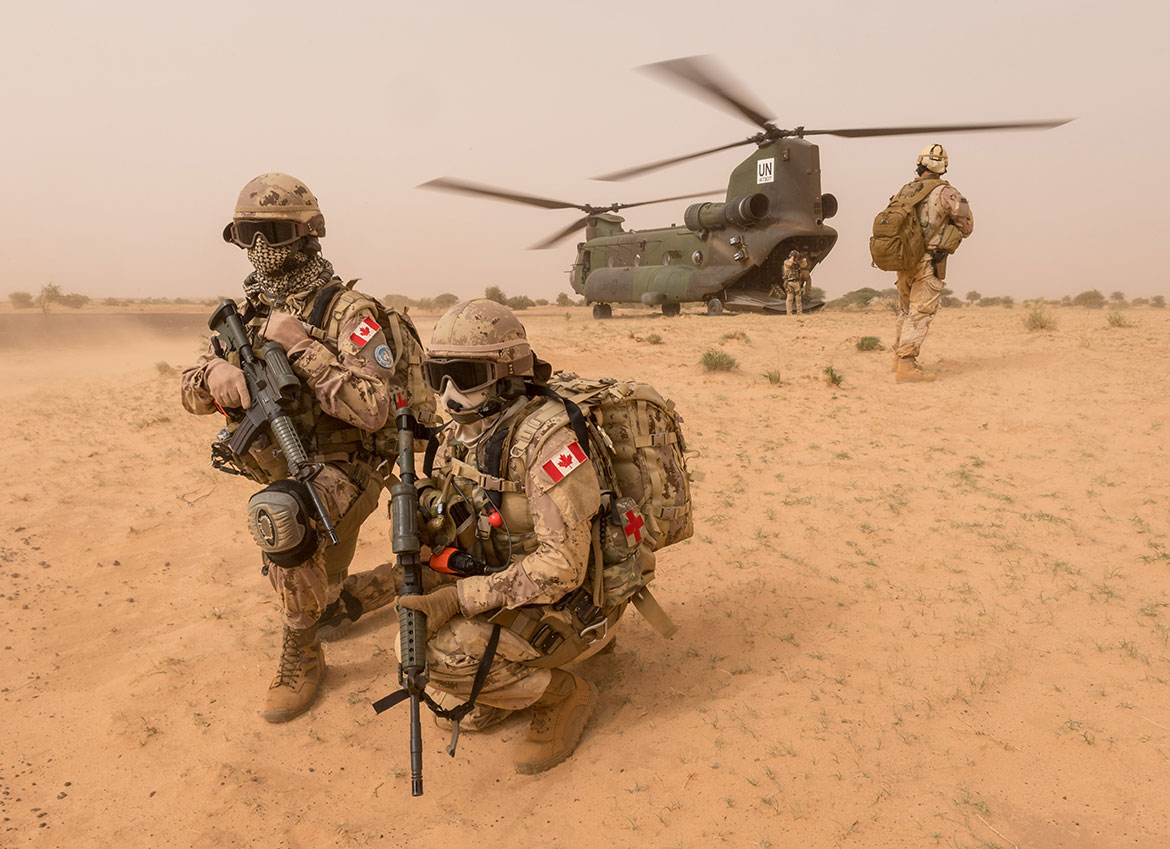The man who led Canada’s troops in Afghanistan said the Canadian peacekeeping mission in Mali has “no prospect of immediate success.”
 |
| Gao, Mali. July 18, 2018 – Photo has been digitally altered for operational security. Members of the CH-147 Chinook medical team practice exiting the helicopter under the watchful eye of the force protection team in support of Operation PRESENCE - Mali around Gao, Mali. (Photo: MCpl Jennifer Kusche) |
“The political overtones and what’s going on in this country and this mission are ugly,” retired major-general David Fraser told CTV’s Power Play host Don Martin on Monday.
“This is not going to be short mission.”
Canadian boots hit Malian soil in June for what has widely been regarded as a dangerous year-long peacekeeping mission. While Canada’s role is primarily to fly medical evacuation missions and provide support from the skies, the security situation in the region is said to have sharply deteriorated in recent months.
That’s something that hasn’t escaped Fraser’s notice.
“It’s as bad -- if not worse -- than what we experienced in Afghanistan, Iraq or Syria,” Fraser said of the conditions in Mali.
“It doesn’t take a rocket scientist to figure out that this mission isn’t going in the right direction from a trajectory point of view.”
His comments echo the revelations of a United Nations report released Wednesday. The assessment, conducted by UN Secretary General Antonio Guterres, described a plummeting humanitarian situation in Mali. Food aid and other humanitarian relief is in overwhelming demand and the country, according to the report, is faring worse in many ways than when Canadian peacekeepers first arrived in June.
Fraser explained that the key issue marking this decline is a lack of leadership. Despite successful elections in July and August, he said the insurgents are “winning the fight on the ground.”
“Peacekeeping can’t be effective. It can’t be effective without a strong civilian government leadership that’s running the government, that’s actually providing oversight for the military and the police forces and that’s not happening fast enough,” Fraser said.
“The race is being won not by the government and not by the military -- it’s being won by the people we don’t want to win.”
That on-the ground reality means humanitarian efforts aren’t getting to where they need to be.
“Aid, from a strategic and from a tactical point of view, is not getting to the ground fast enough,” Fraser said.
And at the end of the day, Fraser warned this hurts some people more than others.
“The local people are the ones who are going to be adversely affected,” he said.
To change this, the UN needs a change in their approach, according to Fraser.
“The UN’s not getting the locals to get the leadership or the women engaged fast enough, and they’re going to lose this race.”
If nothing changes, Fraser warned, we can expect the situation to continue to deteriorate -- and the UN reports to harshen.
“The people that are adversely affected are women and children and the innocent people, which is just going to make the next report card even worse than this one,” he said.
“This is not going to be short mission.”
Canadian boots hit Malian soil in June for what has widely been regarded as a dangerous year-long peacekeeping mission. While Canada’s role is primarily to fly medical evacuation missions and provide support from the skies, the security situation in the region is said to have sharply deteriorated in recent months.
That’s something that hasn’t escaped Fraser’s notice.
“It’s as bad -- if not worse -- than what we experienced in Afghanistan, Iraq or Syria,” Fraser said of the conditions in Mali.
“It doesn’t take a rocket scientist to figure out that this mission isn’t going in the right direction from a trajectory point of view.”
His comments echo the revelations of a United Nations report released Wednesday. The assessment, conducted by UN Secretary General Antonio Guterres, described a plummeting humanitarian situation in Mali. Food aid and other humanitarian relief is in overwhelming demand and the country, according to the report, is faring worse in many ways than when Canadian peacekeepers first arrived in June.
Fraser explained that the key issue marking this decline is a lack of leadership. Despite successful elections in July and August, he said the insurgents are “winning the fight on the ground.”
“Peacekeeping can’t be effective. It can’t be effective without a strong civilian government leadership that’s running the government, that’s actually providing oversight for the military and the police forces and that’s not happening fast enough,” Fraser said.
“The race is being won not by the government and not by the military -- it’s being won by the people we don’t want to win.”
That on-the ground reality means humanitarian efforts aren’t getting to where they need to be.
“Aid, from a strategic and from a tactical point of view, is not getting to the ground fast enough,” Fraser said.
And at the end of the day, Fraser warned this hurts some people more than others.
“The local people are the ones who are going to be adversely affected,” he said.
To change this, the UN needs a change in their approach, according to Fraser.
“The UN’s not getting the locals to get the leadership or the women engaged fast enough, and they’re going to lose this race.”
If nothing changes, Fraser warned, we can expect the situation to continue to deteriorate -- and the UN reports to harshen.
“The people that are adversely affected are women and children and the innocent people, which is just going to make the next report card even worse than this one,” he said.
